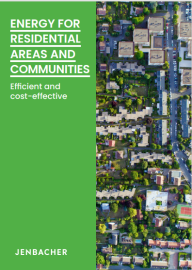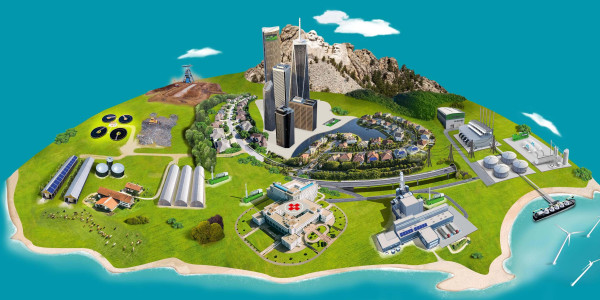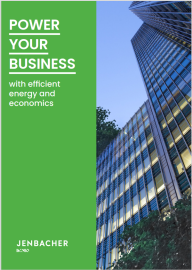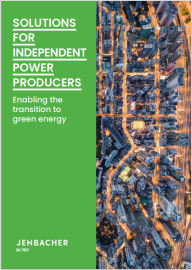Selecting Power Generation Equipment
Important aspects to consider.
There are many solutions that can be considered for power generation applications. If gaseous fuel is available, many customers today are weighing the pros and cons of reciprocating gas engines, gas turbines and other gas-fired solutions. In this article, Jenbacher experts provide our thoughts on what you should consider when selecting power generation equipment.
First, however, here’s a little background on reciprocating engines: They are used in a wide variety of power generation applications across different industries, from food and beverage applications that use less than 1 MW to industrial segments of up to 100 MW. And then there are even bigger projects for major utilities, such as the recently commissioned 190 MW project for the Stadtwerke Kiel in Germany. This large combined heat and power (CHP) project uses Jenbacher J920 FleXtra gas engines.
As a company that produces dependable Jenbacher reciprocating gas engines with electrical efficiency usually ranging between 40% and 50%, we know that gas engines often can be compared with gas turbines or any other conventional power generation technology. Moreover, gas engines can work in combination with other types of equipment, renewable energy sources or battery storages, increasing the efficiency and flexibility of the overall system. Finally, gas engines are used successfully to modernize or repower current power generation infrastructure.
Important aspects to consider when selecting power generation equipment
Because we share your desire to find cost-effective, technically reliable and greener power generation solutions, we urge you to pay attention to the following factors when comparing different technologies:
-
Capital expenditures
This is one of the most important considerations for our customers. Gas engine solutions offer very competitive installed costs/kW for projects that are just a few hundred kWs to those with multiple MW installations.
-
Electrical and overall solution efficiency
You’ll want to determine how much gaseous fuel your power plant will consume. Typically, 75% of the cost of energy produced is the cost of fuel, so efficiency is very important.
Jenbacher* gas engines are highly efficient, with the maximum electrical efficiency reaching well over 45%. Jenbacher equipment works in cogeneration solutions, efficiently converting the primary energy of the gas fuel into electricity and heat. In cogeneration mode, overall efficiency can reach even higher than 90%.
-
Equipment production and commissioning timeline
The total production time of Jenbacher gas engine power plant components plus the time for construction and commissioning usually falls between 8 and 16 months (time to Commercial Operation Date). Your time to COD could be even shorter if units are in stock. That means you can start receiving the economic benefits of onsite power generation with gas engines in a fairly short time.
-
Modularity and availability of ready-to-use solutions
When INNIO designs our solutions, we take into account our equipment’s eventual delivery to the installation sites. Our solutions can be installed in buildings or can be packaged into easily constructed modular structures. For example:
- Jenbacher Type 2, 3, 4 and 6 engines are packaged in standard containers measuring 2.4 and 3 meters wide.
- Jenbacher 920 FleXtra engines typically are built in a very modular design.The modularity of our solutions makes project logistics easier. In addition, ready-to-use solutions allow you to accelerate the commissioning of the project and effectively scale up your power plant in the future.
-
Operational expenditures (OPEX)
Another very important factor in determining the choice of technology for a power plant is operational expenditures associated with the installed equipment.
You should consider such aspects as: maintenance intervals, works and spare parts cost, downtime during repairs, and equipment lifecycle duration before overhaul. We recommend customers compare the cost of the equipment’s entire lifecycle.
To minimize equipment downtime during major repairs, Jenbacher has developed long block and short block solutions that deliver overhauled engines that meet the quality and performance standards of our new units. Reach out to one of our experts to learn more.
Jenbacher also offers multi-year service contracts and Asset Performance Management tools. These help to reduce the need for spare parts and can predict service events, lowering costs throughout the engine’s lifecycle.
-
Limitations on start/stop events frequency
Definitely take this factor into account, especially if you are not going to operate your equipment 24/7 and plan to stop it periodically.
Make sure to check the maximum possible start/stops within the equipment’s lifecycle, which is stipulated by some equipment manufacturers. When such limits are surpassed, the actual equipment lifecycle can be shortened, meaning you’ll need an earlier overhaul. In some cases, power generation equipment manufacturers might even require additional service payments for every start.
If you consider using gas engines, our experts can advise you whether this factor is applicable for your particular project depending on planned start/stop events frequency.
-
Time to full power output and maneuverability
Our experts can help you select equipment that suits your requirements by analyzing your project’s load profile. Jenbacher's gas engine product line covers a wide range of power outputs—from 0.3 to 10.6 MWs—we can help you find a solution that fits your specific application.
You also should determine how quickly you need your power generation equipment to reach a given capacity—a factor that is especially relevant for such applications as data centers, medical institutions, oil & gas, and grid firming/peaking applications.
The standard startup time for Jenbacher gas engines is 5 minutes from initializing the start to reaching full output. Some Jenbacher Type 4 engines can reach full output in less than 2 minutes and a special version of our J620 engine achieves a full 3 MW of electric output in less than 45 seconds. The J920 FleXtra, our 10.6 MW engine, can reach full power in less than 3 minutes.
Time to full power output may vary depending on technology and model. In some cases, it could take longer than 10 minutes to reach full power and for complex application it could take even more than 30 minutes. We suggest to look closer at this aspect if maneuverability is an important factor for your project.
-
Partial load efficiency
If you plan to run equipment at partial load for significant periods of time, you’ll want to seriously consider potential efficiency reduction issues. Equipment usually reaches the nominal efficiency parameters at rated power output, but at partial load, efficiency may be lessened. For Jenbacher gas engines, this efficiency decrease is quite moderate, while for other types of power generating equipment, it can be much more significant.
Moreover, our experts can consult with you about selecting engines that best fit your load profile, thereby decreasing periods of partial equipment load.
-
Power output tolerance to ambient parameters
The ambient conditions under which you will operate your equipment can have a big impact on its actual power output capacity. In other words, under certain conditions your power output may be much lower than the rated power level. Pay attention to this factor if you plan to operate the equipment at high temperatures and/or at an altitude significantly above sea level.
Our gas engines typically provide full output up to 86°F and more. Our gas engines keep rated power outputs at high altitude above sea level. Contact our experts to find out more.
Why on-site power generation?
In addition to these factors, onsite power generation may provide you with significant benefits, such as:
- Decreased energy-related operating costs. When energy is produced at the place of its end use, costs can be lower than when energy is supplied by a third party via grid and central systems.
- Avoided energy losses due to electric power distribution from central power stations to distributed consumers.
- Avoided expensive power transmission and distribution upgrades due to increased local demand.
- Prompt access to electrical and thermal energy. This is especially important for energy-deficit regions and for locations that don’t have the ability to connect to centralized energy sources.
- Improved reliability of the electric power source for locations with unstable grid infrastructure and for facilities with increased requirements for energy supply reliability.
Learn more about on-site power generation here.
OUR EXPERTS ARE READY TO HELP YOU
Whether your business is looking for onsite power solutions, access to electricity, decreased energy costs, or even to sell electricity back to your local grid/consumers, Jenbacher´s regional experts can advise you on which solution makes the most sense for you.
Get in touch for free consultation on the following:
- The benefits of onsite power generation solutions for your company
- Potential financial benefits using economic modeling
- Consultation on the technical side of your project - fuel types, feasibility studies, equipment and balance of plant selection, and more
- Regional incentive programs relevant to your business
- Options to deliver your project: purchasing, financing and leasing, engaging a service provider (ESCO, BOO etc.)
- How to meet emissions targets
Fill-in contact form, or send us an email contact.en@innio.com.
Consult an expert
Send us a message and we’ll contact you to start the conversation.
Whether your business is looking for onsite power solutions, access to electricity, decreased energy costs, or even to sell electricity back to your local grid/consumers, Jenbacher regional experts can advise you on which solution makes the most sense for you.
Resources & Downloads
Jenbacher NAM Webinars–Designing Your Power Plant 2022
Language: English
Category: Webinars
Jenbacher North American Webinars – Designing Your Power Plant 2022
CHP Residential areas & municipalities
Language: English
Category: Brochures
CHP Residential areas & municipalities Brochure US



